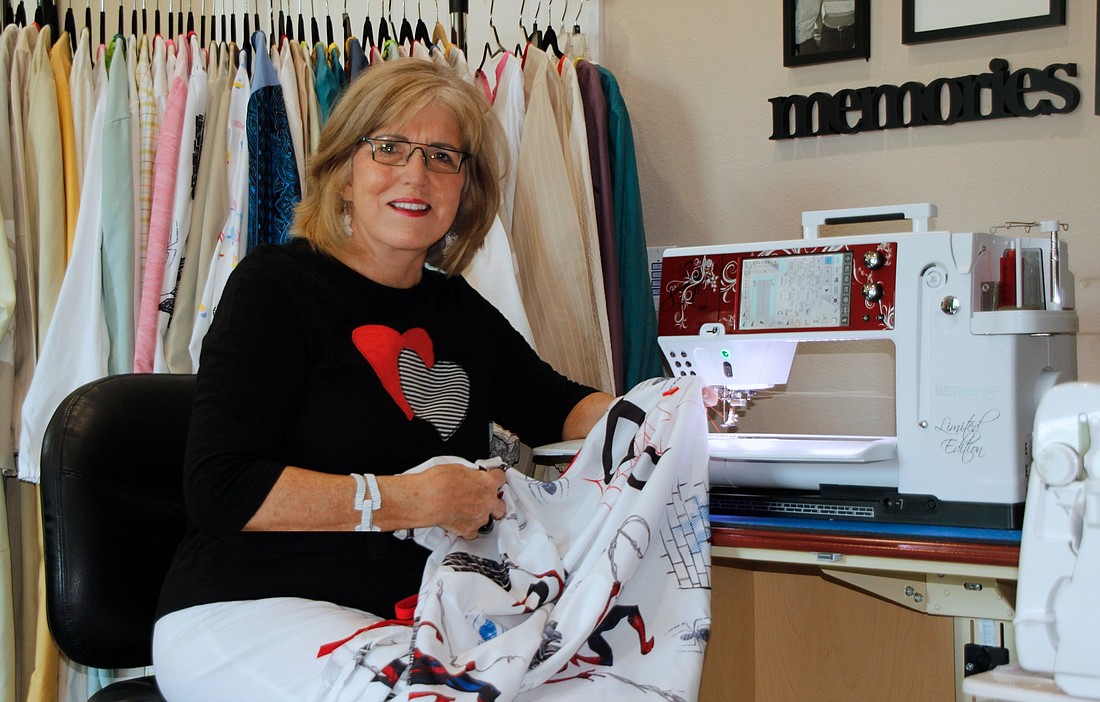- November 5, 2025
-
-
Loading

Standing outside the University Park Joann Fabric and Craft store at 9 a.m., an hour before the store opened, Lakewood Ranch’s Katherine Benoit focused on her sole objective: bias tape.
"I thought I might be in over my head, but it turns out it has been nice to be a part of something bigger than myself." — Katherine Benoit
Benoit, 70, was sixth in line, which meant she had a good chance to grab all of it if she hurried. When the clock struck 10 a.m., Benoit raced to the correct section and grabbed the lot of it. It came out to $256 at the register, where, after paying, Benoit asked the checkout worker on a whim if she could grab any bias tape available in the checkout counters’ drawers. The worker acquiesced, to Benoit’s delight. She promised her it was going to a good cause.
Benoit, an active member of the community, needed the bias tape for her latest venture. She was, and is, making garments for Tidewell Hospice workers during the coronavirus pandemic, and the tape simplifies and speeds up the process of sewing the gowns. At first, Benoit says, she focused on masks, but since the end of March, Benoit has been making isolation gowns, which cover the majority of medical workers’ skin, creating a barrier between themselves and their patients. Benoit says she was informed that gowns were in higher demand because everyone started making masks at the same time.
Not everyone contributing to the cause has been as committed as Benoit, though. Her garment-making journey began with an urge to help and an open call to her friends March 21 asking for sheet donations. When Benoit received 500 sheets in response — a number she says still shocks her — she was faced with two options. She could work alone until she got tired of it, letting many of the donations go to waste, or she could rally the troops.
Benoit chose the latter, becoming less of a sewing machine and more of an armchair general by roping approximately 20 of her friends into the operation and giving each one a specific job to do in their homes. Some cut out the patterns. Others sewed material together. Still others used serge sewing machines for a finishing touch or volunteered to drive the gowns from one operation to the next.
Benoit, the Don Corleone of isolation gowns sewn, coordinated these efforts and did the little things, such as washing the gowns before packaging them and stitching a heart symbol on the chest to give each gown a signature touch.
Thus far, Benoit estimates that the group has completed 100 gowns, with 100-200 more in the pipeline. Each gown can be washed, which makes them invaluable to workers who had previously been forced to wash disposable gowns, limiting their effectiveness.
“Everyone wants to help somehow during this time, but some people do not know how,” Benoit says. “I happen to be at home, isolated, and I sew on my own anyway. I have an addition on my house that is only a sewing room. I didn’t plan on doing all of this at the beginning. I thought I might be in over my head, but it turns out it has been nice to be a part of something bigger than myself.”
Bernadette Meisenheimer, a friend of Benoit’s, has been helping her with sewing and has even recruited a few people to the team herself. Meisenheimer laughs and says she has 15 gowns hanging on her closet door because of Benoit. She is not the least bit surprised it is her friend spearheading the grassroots movement.
“Katherine loves being involved,” Meisenheimer says. “She is always doing something, whether it is making jewelry or being on the board of the [Sarasota] Opera. She puts things on her own shoulders and carries them. She is intelligent and organized. I cannot think of a more perfect person to be putting this together.”
At the onset of the journey, Benoit says she was met with resistance from some people she queried about the gown-making process. One of her acquaintances, a nurse, told Benoit she did not see the point in making gowns at all. Hospice workers don’t need them, she says, and they are not that effective anyway. Benoit says one phone call to Tidewell Hospice proved the nurse’s theory incorrect, but being challenged like that gave her even more motivation to do whatever she could to help.
She does not plan on stopping any time soon.
“I am having so much fun,” Benoit says. “I get to work with friends and with people I have never met before. People will come pick up gowns in their golf carts, and I’ll chat with them from a distance. It’s nice.
“The best thing, though, is seeing the gowns being put to good use.”